I am very honored to be a contributing artist in a research study done in the UK by Lorraine Tolmie about art and extrasensory perception.
Learn more and get your free e-book here!
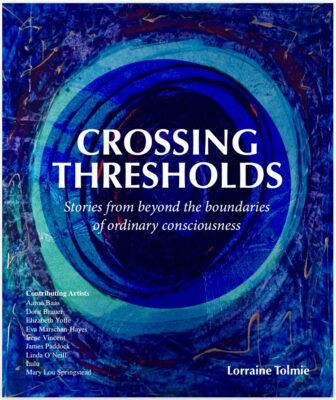
Dorit Brauer is an abstract painter and author living in Pittsburgh. The style of Dorit’s work has shifted and evolved, mirroring stages of her life. She shares that every time she travels something new happens in her art. As the founder of The Brauer Institute of Holistic Medicine, her work in this domain is deeply interwoven with her creative practice.
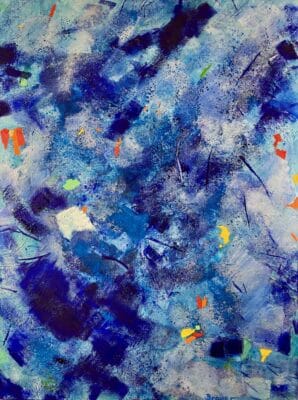
STORM TEMPLE – AN UNEXPECTED DISCOVERY
During the pandemic, the aesthetic style of Dorit’s painting shifted dramatically. Inspired to create work that was calm and soothing, she created a series of blue and silver paintings titled the Cosmic Resurgence Series. On the first layer of the artwork that came to be titled Storm Temple, she wrote the Hebrew word אֶמֶת Emet, Truth. Over this, she painted another layer with abstract symbolic forms, “wild stormy waves and twigs of branches blowing across the surface cover the truth, yet underneath the calm true place prevails.” While quietly contemplating the finished artwork, she suddenly felt a strong impulse to make a few final brushstrokes with the white paint remaining on her palette. This was not a carefully considered aesthetic decision or a conscious movement; Dorit followed an intuitive felt-sense that guided her to a very particular area on the canvas. Moving back to observe the painting in its altered state, she experienced a powerful sense that she was looking at a sacred temple. Then, a face of a young man began to emerge in the form of those final brush strokes, becoming more prominent and three-dimensional as the oil paint slowly dried. Dorit had a strong feeling of wonder at the appearance of this man, who had appeared “gazing at the viewer across time and space.”
For Dorit, this was an extraordinary and meaningful experience. On one level it was a symbolic representation of her fascination with the unknown, and the mysterious aspects of life that resist comprehension. As well as being fascinated by what happened, she also describes it as baffling. Even though unexpected developments often unfold through her creative process, this particular occurrence felt like a direct connection to a mysterious source, beyond the material world. Dorit has chosen to keep Storm Temple in her home because she feels that she is evolving with it. Looking at the painting also reconnects her to the uplifting emotions that arose during its creation. When she sees the face of the young man she sometimes has chills, and feels connected to a higher presence. Ultimately, Dorit feels that the resulting revelation has opened a pathway leading to another stage in her spiritual and creative journey.
BACKGROUND
Growing up on a secluded dairy farm in Rees, in the Rhine Valley, Dorit’s vision was to be an artist and writer. Her parents had a more traditional outlook, and she was encouraged to pursue a conventional path. After trying various different things, and feeling unsatisfied, she embarked on a back-packing trip to Brazil. On this journey, Dorit met a group of Israeli travellers and discovered that her name, which was unusual in Germany at the time, was of Hebrew origin. Learning this fostered a curiosity that led her to move to Tel Aviv where she studied Hebrew, enrolled in art school, and took courses in holistic medicine.
Dorit admired abstract art, particularly the work of Joseph Beuys, Lea Nikel and Moshe Gershuni. Although she strove to paint in this style herself, it didn’t flow naturally, and she was more at ease creating figurative and landscape art. After attending a class in bio-energetic medicine that involved working on energy fields, there was a dramatic shift. The painting she created after this class emerged intuitively, and she recalls feeling as if she had found her language. Something had occurred that enabled her to tune into and follow an inner flow that facilitated free expression. She believes that this same process can bring unexpected solutions in other situations, “just that openness, something will come to you that suddenly pops and you’re not the same person anymore, and things work.” In life, and art, she sees this quality of receptivity as key.
Although living in Tel Aviv was a transformative experience, it was also tumultuous. Dorit was there during the Gulf War, and recalls scud missiles dropping during the military operation, Desert Storm. Painting became a way of processing the intense events and terrorism she lived with at the time. Following a knife attack near her home, she covered a canvas in black paint, inscribed the Hebrew letters that convey the concept of original chaos, spattering the canvas with red blotches to represent blood.
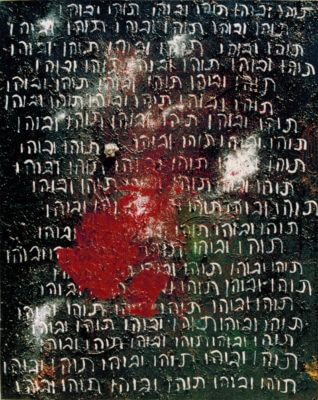
During her time in Israel, Dorit also received tragic news that her friend, Holger, had died of an overdose. To process this personal loss she created a triptych, titled Three Paintings For Holger.
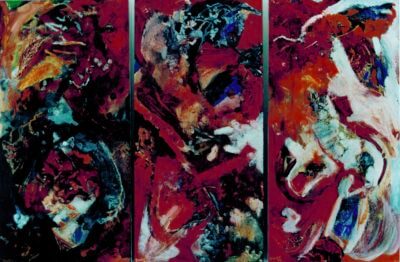
Seventeen years later, while working on a book, she attended non-fiction and poetry classes. Searching for a subject to write about she began to reflect on her time in Israel. This resulted in a poem that interweaves aspects of the narrative surrounding Holger’s death with the content and creation of the three paintings, and the reactions of other people to the imagery.
Three Paintings for My Friend Holger
A light blue air mail letter
two pages long and at the end three words
Holger is dead.
Holger
always curious about the world beyond
recommended Carlos Castaneda, Don Juan and peyote.
Three abstract oil paintings follow:
Earth,
your body
disintegrates.
A friend sees a pregnancy
a womb and a fetus.
Is there rebirth after death?
Two faces
a man and a woman
making love.
My hand shakes as I phone my mom.
What happened? I ask.
He OD’d, was found with the needle still in his arm.
I knew you would hurt.
Light,
an unfathomable revelation.
Many years later a friend
recognizes the features of Hitler:
his eyes nose mustache.
I am shocked
unable to escape my German roots.
I see people afraid to fly.
I paint and remember a dream days
before the letter arrived.
You came to me to say good-bye, hugged me:
We will not see each other again in this life.
Heaven,
Too much red in retrospect
red love red pain
a woman prays on her knees.
Two men engage in casual conversation
misplaced in a bubble of blue amidst the red
unaware of their surroundings
smoking pipes.
While in Israel, Dorit’s artwork also explored her identity as a non-Jewish German person, and her sense of belonging was deeply torn. In addition to feeling uprooted, she was struggling with feelings of guilt related to the historical trauma between these two countries. However, on returning home to Germany after eight and a half years, she discovered that she was no longer content there and intended to move back to Israel. Her plans changed when she met an American, the man who would become her husband, and she moved to Pittsburgh in Pennsylvania. Even though she and her husband later separated, Dorit has remained living there for twenty three years.
In stark contrast to the experience of living in Tel Aviv, Dorit describes Pittsburgh as very peaceful. Although many miles from her place of birth, she feels a sense of having returned to her roots because she spends a lot of time in nature. Now, instead of a tool to process the darker aspects of life, her artwork aims to communicate a sense of joy and peace, and convey the innate healing power that exists within us all. Over time, her meditation practice had cultivated a calm centre of inner peace that is not dependant on external events, and can be used as a resource, even when life is in turmoil.
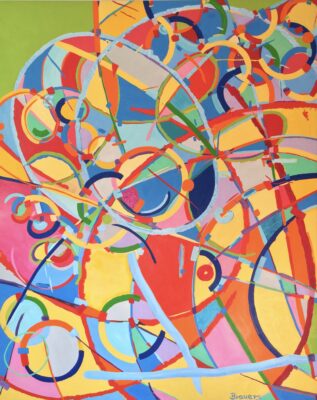
The colourful paintings in the Unwinding Series were inspired by a vivid dream where Dorit’s father guided her to a studio filled with a cornucopia of art materials. Bringing this meaningful dream to life, Dorit gathered supplies and began recreating the abstract art that she had been shown in her night-time vision. This series, which is awash swirling colours from across the spectrum, is intended to connect with the concept of unwinding in holistic medicine. Dorit views unwinding as a shift into a more expansive movement, and a release of past emotions such as stress, fear, and worry that have been stored in the body and become restrictive.
In 2020, the pandemic and resulting lockdown catalysed a significant life shift for Dorit. Her holistic medicine centre had to be closed due to the restrictions, and she became increasingly aware of her immigrant status in the US. This became an introspective, solitary time when she deepened her meditation practice, and focused on painting. The ebullient style of her recent work no longer felt attuned to the atmosphere that was prevalent at this time, and so the Cosmic Resurgence Series emerged with shades of blue and silver. As well as a colour that was connected to many positive shifts in her life, Dorit felt that blue was a protective, soothing colour that would express peace, confidence and trust. Silver, which Dorit associates with the crown chakra, was also prominent to emphasise a higher spiritual dimension.
The deeper meaning of colour is an important aspect of Dorit’s artistic practice and her mindful painting classes. This concept originally came to her attention while in holistic medicine school in Tel Aviv. When the teacher asked the students to report on their least favourite colour, he was amused when Dorit shared her strong aversion to red. He explained that red was connected to the root chakra and advised her to get more exposure to this colour, such as wearing red clothing. Although initially very resistant to the advice, Dorit eventually bought a cheap red t-shirt at a market and only wore it at night. It was only after several months, and enduring pressure from her teacher, before she could wear it to class. On reflection, she came to understand that this was likely related to her sense of upheaval after leaving her German roots. Since embracing red helped to heal this inner trauma, she now believes that including all colours is extremely powerful tool, and also an analogy for an accepting and inclusive attitude to all aspects of life.
At the age of forty, Dorit embarked on a solo cross-country motorbike trip across the US, to walk labyrinths. While in California, she crashed her bike, and as a result of the trauma and pain on impact, had an out of body experience. Although she had previously experienced a sense of detachment from her physicality during deep meditation, this was different. It was the first time she had experienced her consciousness as being completely disconnected from her body, as if it was located somewhere entirely different. This event left her with a strong conviction that consciousness continues after death. After this journey, she shifted to writing as a new form of creative expression and spent six years writing her award-winning autobiography, Girls Don’t Ride Motorbikes: A Spiritual Adventure Into Life’s Labyrinth.

CREATIVE PROCESS
Dorit feels that her meditation and painting practices work in synergy, and that her work in holistic medicine nourishes her art. Considering the creation of art to be a sacred process, she only begins painting when she is “in an inner state of unity, which transcends polarity and feels like an elevated state of mind.” To cultivate this state, Dorit typically spends time in meditative preparation, including contemplation, sketching, and reflective journaling.
For Dorit, the process of being receptive and present in the moment creates the opportunity for the unexpected to arise in her paintings. She sees this open awareness as a way to allow creative inspiration to flow through her. Words she uses to describe this process are: happy, in the flow, in the moment, connected, peaceful, ecstatic, and surprised. The process is similar with her other creative endeavours, and she finds that writing by hand, rather than using a computer, is the key to connecting to her natural flow. If she has writer’s block she will keep her pen to the page, and begin to scribble or make sketches, until the flow returns.
When she is not in her studio, Dorit is always gathering information, and believes that all her experiences contribute to her art. In respect to this, she shares the German word Lebenskünstler, meaning to be an artist of life. This is a concept that she feels is essential because it relates to conscious living, “imagining your life as a blank canvas and then how do you paint it?” In this way, she says, your whole life becomes a work of art.

SENSITIVITY & PERCEPTION
Dorit started meditating at the age of fifteen, after losing a childhood friend to lung cancer.
Struggling to find answers from her family, or at church, she began to find wisdom in books. The local librarian introduced her to various authors writing on subjects such as reincarnation and life after death. As a result, she was exposed to different theories and perspectives at an early age, reading Elizabeth Kubler Ross, Raymond Moody, Edgar Cayce and Ian Stevenson. When she came across meditation exercises in the books, and began to try them out of curiosity, she was surprised at the ease with which visions would appear in her mind’s eye. Having now meditated for over forty years, Dorit has become very attuned to her inner world. She does guided imagery meditations daily, and believes that this long-standing practice has changed her perception of reality. Experiencing a sense of unity through meditation has led to an embodied sense of a space beyond polarity. She takes time to regularly check-in with herself, and views this as essential to escaping the negative trance of mass consciousness. When she experiences difficult emotions like fear, anger, or worry she feels equipped to return to a peaceful state with more ease.
Although her father was initially apprehensive about Dorit’s interest in energy medicine, and questioned what good could come of it, he later confided that he had an unusual ability. From a young child he had been able to identify when women were pregnant, despite there being no visible sign. The first time this occurred was when he was five years old, but it was summarily dismissed as childish imaginings. Later, his knowledge got him into a few troublesome situations and so he learned to keep it to himself. When asked to explain how he could identify pregnancy, he simply said that the light changes around the woman. Reflecting on her dad’s abilities, and her own path into energy work which included developing the ability to see auras, Dorit wonders if there could be other links to this throughout her family’s lineage.
Dorit is very conscious of her inner space. She finds being in crowds challenging, and avoids being around too many people, which can be exhausting. Superficial connections can also be draining, and she prefers one to one interactions and deep conversations. As she gets older, she is discovering how essential it for her to take solitary time to recharge. Spending time in nature is essential for her wellbeing, and she finds it rejuvenating.
For the last thirty years, Dorit has studied the Kabbalah. In line with these wisdom teachings, she views the external world as a reflection of the inner self. She considers her inner world and external world to be interwoven, and of equal significance in facilitating her personal growth. Although she does not see a separation between the inner and outer, she feels grounded and has a strong discernment of where she is in the present moment.
Related Article: The Day I painted Abstract
View Storm Temple at the Hoyt Art Center:
